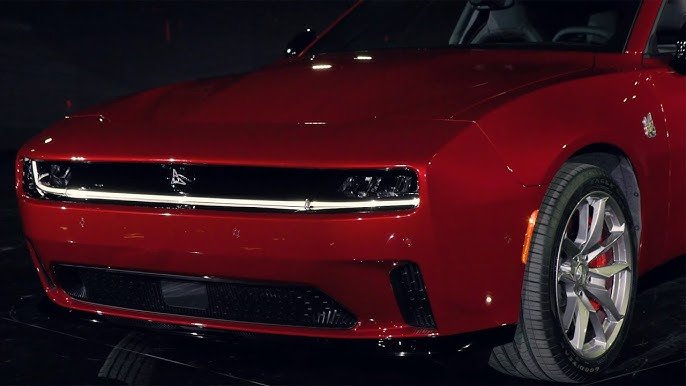For decades, the Dodge Charger stood as a symbol of raw American power. Big V8s, brutal acceleration, and an unmistakable road presence made it a favourite of everyone from street racers to daily commuters who just wanted a little more attitude.
When Dodge announced that the Charger would go electric, it felt like the end of an era. Fans worried that the roar of a supercharged V8 would be replaced by the silent whoosh of an anonymous electric motor. They wondered whether an electric Charger could even call itself a muscle car.
Now that we have seen the 2025 Dodge Charger Daytona EV, it is clear Dodge had no intention of going quietly into the future.
Here’s the full story of Dodge’s first electric muscle car what it looks like, how it feels, and why it still carries the spirit of a true Charger.
A New Look That Commands Attention
The first thing that hits you when you see the Charger Daytona in person is how much attitude it has. Dodge could have gone the safe route, designing a bland, aerodynamic EV blob. Instead, they built a car that looks like it wants to start trouble.
The front end features a squared-off nose with a sharp crease running across the hood. Instead of a traditional grille, there’s an aerodynamic air pass-through Dodge calls the R-Wing, designed to keep the aggressive face while improving airflow.
A full-width light bar runs across the back, framing a glowing Fratzog badge a throwback to Dodge’s performance history. The side profile stays true to classic muscle car proportions: long hood, short rear deck, wide shoulders.
Massive wheels, deep side skirts, and a hunched stance complete the look. This is a car that feels like it belongs in the same lineage as the Chargers of the 1970s, even without a roaring V8 under the hood.
How It Drives: Instant Violence at Your Command
The heart of any muscle car is performance, and the Daytona delivers.
Dodge will offer several versions, but even the lower trims are expected to deliver over 400 horsepower. The range-topping Scat Pack Daytona will crank out more than 670 horsepower and 640 pound-feet of torque.
Acceleration is immediate and brutal. Without the need to rev up or shift gears, the Charger Daytona simply explodes forward the moment you touch the pedal. Dodge says the high-performance versions will hit 60 miles per hour in about 3.5 seconds.
The sensation is different from an old Hellcat. Instead of a dramatic build-up, there’s just pure, silent violence that throws you back in the seat and squeezes the breath out of you.
Handling is sharper too. Thanks to its low center of gravity and balanced weight distribution, the Daytona corners flat and responds quickly to steering inputs. Dodge added adaptive suspension settings that let drivers switch between Comfort, Sport, Track, and Drag modes, adjusting everything from steering weight to shock stiffness.
The Charger Daytona feels heavy in the right way solid and planted without being clumsy.
The Sound: Not Quiet, Not Fake
One of the biggest criticisms of EVs is the lack of sound. Dodge tackled this head-on.
The Fratzonic Chambered Exhaust system is an actual exhaust setup that pushes real air through tuned pipes, creating a sound that Dodge says can reach 126 decibels — as loud as the old Hellcat.
The sound is futuristic but mechanical. It is not a fake V8 note piped through the speakers. It’s a deep, throaty growl that changes pitch and volume depending on how hard you’re driving.
In person, it gives the Charger Daytona a real sense of drama and theater. You can hear it rise and fall through corners, bark on throttle lifts, and howl under full acceleration.
It’s not exactly the same as a supercharged V8, but it is loud, raw, and alive — which is more than most EVs can say.
Interior: A Modern Muscle Cockpit
Inside, the Charger Daytona feels like a futuristic muscle car should.
The dashboard is low and wide, with a massive 16-inch digital gauge cluster in front of the driver and a 12.3-inch center touchscreen. Both screens are angled slightly toward the driver, reinforcing the cockpit feel.
Materials are sporty but upscale. Suede, leather, real metal accents, and textured plastics are used thoughtfully throughout the cabin.
The center console houses a pistol-grip shifter that feels substantial in your hand. Even though it’s controlling electric motors, it offers a satisfying mechanical click as you shift into drive or reverse.
Ambient lighting wraps around the cabin, with multiple color options to match your mood. Sports seats hold you tightly without being punishing, and rear-seat passengers get more space than you might expect in a two-door coupe.
Tech features include wireless Apple CarPlay and Android Auto, a head-up display, and Dodge’s new performance pages, which allow drivers to monitor power delivery, battery temperature, and lap times.
Real-World Living: Daily Driver Muscle

One of the most surprising things about the Charger Daytona is how livable it is.
The ride in Comfort mode is smooth enough for commuting, and the adaptive air suspension soaks up potholes and rough pavement without drama.
Estimated range is around 400 miles on the lower trims and closer to 300 miles on the high-performance versions. Thanks to its 800-volt electrical architecture, the Daytona can charge quickly, gaining about 100 miles of range in ten minutes on a fast charger.
Towing isn’t in the cards, but the car’s hatchback design means there’s real trunk space — perfect for groceries, gym bags, or a weekend getaway.
And with all-wheel drive standard, the Daytona is ready for rain, snow, and anything else the daily grind throws your way.
This isn’t just a weekend toy. Dodge designed the Charger Daytona to be a real car you can live with year-round.
Ownership Costs: Saving at the Pump
Compared to the old gas Chargers, ownership costs should drop significantly.
No oil changes. No spark plugs. No belts, hoses, or exhaust systems to wear out. Brake pads will even last longer thanks to regenerative braking, which uses the motors to slow the car down and recapture energy.
Electricity will be cheaper than premium fuel, especially if you can charge at home.
Insurance might be a bit higher because of the car’s performance and new technology, but overall, the Daytona should be cheaper to maintain than the old V8 models.
Comparison to Rivals: A New Breed of Muscle
How does the Daytona stack up against other electric performance cars?
- Tesla Model S Plaid: Quicker in a straight line but lacks the Charger’s visual drama and raw emotional pull.
- Ford Mustang Mach-E GT: Sporty and fun but smaller, less aggressive, and aimed at a different crowd.
- Lucid Air Sapphire: Hypercar-fast but priced in another universe compared to the Dodge.
The Charger Daytona fills a niche no one else is touching yet: a pure, loud, brash American muscle car that just happens to be electric.
Final Verdict: A Real Muscle Car for a New Era
The 2025 Dodge Charger Daytona EV is not a compromise. It is not Dodge apologizing for going electric.
It is Dodge doubling down on everything that made their cars great power, drama, style, and fun — and bringing it into the future with a new kind of energy.
No, it doesn’t rumble like a V8 at idle. No, it doesn’t smell like burning rubber and race fuel. But it still grabs you by the gut, demands your attention, and makes every drive feel like an event.
If the muscle car is going to survive the electric revolution, this is how it should be done.
And based on everything we have seen so far, the 2025 Charger Daytona isn’t just surviving — it is ready to dominate.






